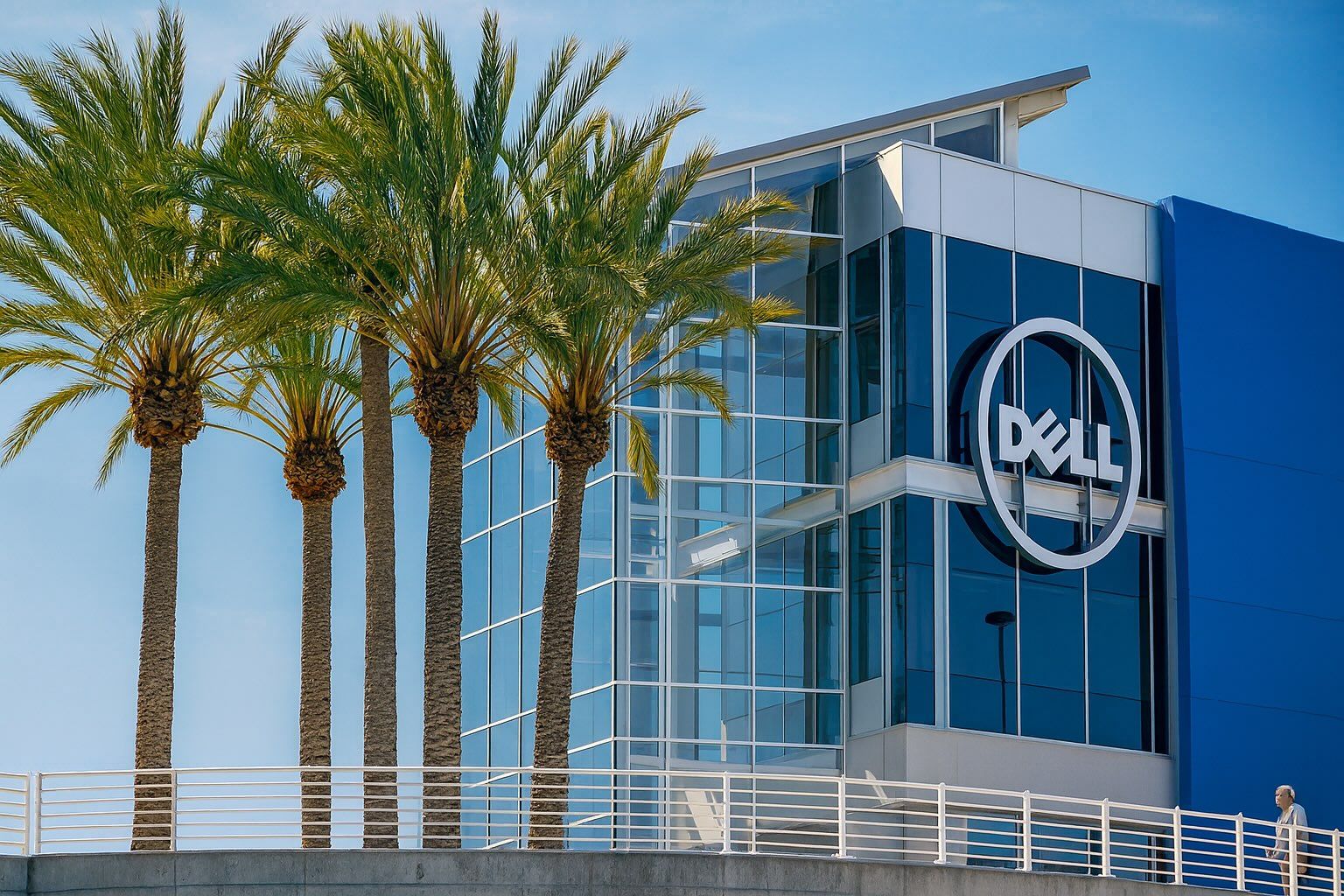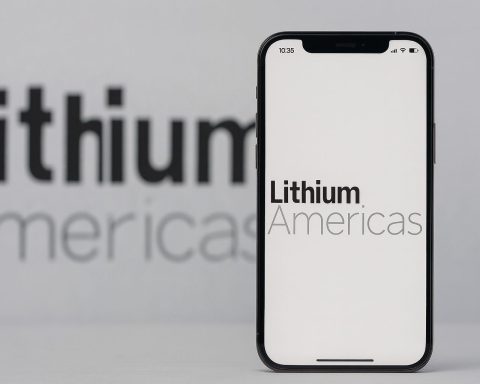- Long-Term Growth Targets Doubled: Dell Technologies dramatically raised its long-term financial outlook on October 7, 2025, now expecting 7–9% annual revenue growth (up from 3–4%) and 15%+ annual EPS growth (up from ~8%) over the coming years [1]. Executives credit surging demand for AI (artificial intelligence) server hardware as the catalyst, with CEO Michael Dell noting “customers are hungry for AI and the compute, storage and networking we provide to deploy intelligence at scale.” [2]
- AI Server Demand Driving Sales: The company’s Infrastructure Solutions Group (servers & storage) is booming thanks to generative AI. In the latest quarter (Q2 FY2026), Dell hit record revenue $29.8 billion (up 19% YoY) with infrastructure sales up 44% [3]. It shipped $8.2 billion in AI-optimized servers and booked $5.6 billion in new AI server orders in just one quarter [4]. Dell even bumped its full-year AI server revenue forecast to $20 billion (from $15 billion), reflecting extraordinary demand [5].
- Investors and Analysts Bullish: Dell’s stock jumped ~7% in premarket trading on the forecast hike [6], extending a rally that’s seen shares gain over 17% year-to-date [7]. Major analysts are upbeat: BofA Securities recently reiterated a “Buy” and raised Dell’s price target to $170 ahead of the announcement [8]. BofA’s Wamsi Mohan projects Dell’s AI server business could add $65 billion in sales over five years, driving ~12% annual revenue growth and ~15% earnings growth, and called even that “conservative” given Dell’s momentum [9] [10].
- Focusing on AI, Cautious on PCs: Dell’s new growth plan leans heavily on AI and data-center tech. It is boosting targets for its Infrastructure Solutions Group – the core of its AI push – while keeping PC (Client Solutions) growth expectations modest [11]. This reflects market realities: corporate buyers are investing in AI-capable servers far more than standard PCs. Dell’s PC division has faced a slump (consumer PC revenue fell 19% in early 2025) [12], but the company sees a coming upgrade cycle as Windows 10’s 2025 retirement and new AI-enabled Windows 11 features spur demand [13]. A Dell spokesperson noted ~30% of the 1.5 billion PCs in use are over 4 years old with no AI chips, representing a “big replacement pool” ripe for refresh [14].
- Shareholder Returns & Outlook: Alongside its growth ambitions, Dell is rewarding shareholders. It doubled its stock buyback authorization with an extra $5 billion approved [15], on top of $5 billion remaining in the current plan. The company also plans to raise its dividend ~10% annually through FY2028 [16], underscoring confidence in cash flow. Despite a strong run-up, Dell’s stock valuation looks reasonable – it trades at only ~0.8× forward sales vs ~7× for the tech sector [17] – suggesting upside potential if AI-driven growth delivers. Analysts note that “Dell shares are cheap” relative to peers given its earnings outlook [18].
Dell’s Bold New Forecasts Fuel Market Optimism
Dell’s announcement on Oct 7, 2025 marked a turning point in the company’s trajectory. At its analyst meeting that day, the tech giant sharply raised its long-term growth forecasts, effectively doubling the pace at which it expects to expand sales and profits in the coming years [19]. Management now targets high-single-digit percentage revenue growth (7–9% annually) and at least mid-teens percentage earnings growth each year [20]. This is a remarkable upgrade from Dell’s prior “GDP-plus” style goals of ~3–4% revenue and ~8% EPS growth, signaling far greater confidence in future demand.
The news instantly electrified investors. Dell’s stock, which had already been trending upward through 2025, surged nearly 7% in pre-market trading on Oct 7 as the revised outlook hit the wires [21]. By the market open, shares were on track for their highest levels in years, reflecting Wall Street’s enthusiasm that Dell’s business is entering a new phase of faster growth. The bold forecasts fed a sense that Dell – often seen as a mature PC-centric company – is reinventing itself as a key enabler of the AI revolution.
Company leadership directly attributed the upgraded outlook to booming demand for AI infrastructure. “Customers are hungry for AI and the compute, storage and networking we provide to deploy intelligence at scale,” CEO Michael Dell said in a statement, explaining the upbeat projections [22]. In other words, organizations globally are racing to deploy generative AI and large-scale machine learning, and they are increasingly turning to Dell’s hardware and solutions to do it. This surge in enterprise AI spending gave Dell the confidence to raise its long-term growth bets – a move that would have seemed ambitious just a year ago.
Notably, Dell’s announcement comes amid an industry-wide scramble for AI-related tech. The company scheduled its Securities Analyst Meeting intentionally to highlight these long-term opportunities. By setting substantially higher growth targets, Dell sent a message that it expects the current AI boom to translate into sustained secular growth for its business, not just a one-off spike. Investors, so far, are embracing that narrative – especially since Dell backs it up with hard numbers from recent quarters (as explored below). The stock’s strong reaction and a flurry of analyst upgrades underscore that market sentiment on Dell has swiftly shifted from cautious optimism to genuine excitement about its role in the AI age.
AI Server Demand – The Game Changer for Dell
The foundation of Dell’s renewed optimism is the explosive demand for AI servers and related data-center hardware. Training advanced AI models (like OpenAI’s GPT or similar systems) and running AI-powered services require massive computing power. Dell, as a leading server manufacturer, is reaping the rewards of this trend in real time. The company’s Infrastructure Solutions Group (ISG), which includes servers, storage, and networking gear for enterprises, has seen unprecedented growth in 2025 thanks to AI.
In its fiscal Q2 2026 (the quarter ended summer 2025), Dell’s ISG revenue jumped to $16.8 billion, a 44% surge year-over-year [23]. This helped drive Dell’s total quarterly revenue to a record $29.8 billion (up 19% YoY) [24], even as the broader hardware market was mixed. The standout factor was AI infrastructure: Dell reported it shipped $8.2 billion worth of AI servers in that quarter alone and logged another $5.6 billion in new ordersfor AI hardware that will ship in coming periods [25]. These are staggering figures – essentially, well over a quarter of Dell’s quarterly sales were tied to AI-driven systems. For context, a year prior AI-related sales were only a fraction of this total, highlighting how fast the ramp has been.
Buoyed by this momentum, Dell raised its full-year forecast for AI server revenue to $20 billion (from a prior $15 billion) during its Q2 earnings release [26]. To put that in perspective, Dell essentially expects AI servers to contribute roughly one-fifth of its overall annual revenue in the current fiscal year. Industry analysts project the broader AI hardware and services market will reach $350 billion by 2028 [27], and Dell clearly intends to claim a healthy slice of that pie. Its growing backlog supports this confidence: as of mid-2025 Dell had roughly a $14.4 billion backlog in AI server orders waiting to be fulfilled [28] – a testament to insatiable customer demand.
Crucially, Dell isn’t just selling vanilla servers – it’s tailoring offerings to AI needs. The firm provides turnkey solutions like the NVIDIA-powered “RTX 6000 AI Factory” systems for enterprises and has been modernizing its data-center portfolio (e.g. new PowerEdge servers, faster storage arrays, etc.) to handle AI workloads [29]. This alignment with what customers need to deploy AI at scale has strengthened Dell’s competitive edge. “Dell’s ability to innovate and deliver turnkey solutions positions it as a leader in the AI hardware market,” noted Zacks Equity Research after the blowout Q2 results [30]. In May 2025, Dell introduced a slew of advanced storage and cyber-resilient infrastructure updates to help companies upgrade their data centers for AI and cloud era demands [31]. All these moves ensure that when a client (be it a tech firm, bank, or government) budgets for a big AI project, Dell’s sales team has an attractive solution ready.
Even tech industry rivals have taken note of Dell’s AI server success. Reports emerged that Apple, pursuing its own generative AI efforts, tapped Dell and another server maker to supply hardware for Apple’s internal AI data centers [32]. (Apple historically designs its own gear or buys from specialized firms, so involving Dell underscores Dell’s credibility in cutting-edge AI infrastructure.) Dell has also closely partnered with NVIDIA, whose GPUs are the brains of most AI systems, to ensure Dell servers can be packed with the latest AI accelerators. This virtuous cycle – high demand leading to strong sales, which funds more R&D and partnerships – is positioning Dell at the heart of the AI compute boom.
Analyst Reactions: “Long-Term AI Winner” Trajectory
Dell’s aggressive push into AI hardware and its raised guidance have drawn applause from industry experts and financial analysts alike. In fact, in the days surrounding the Oct 7 announcement, multiple analysts upgraded their outlook on Dell, citing its AI leverage. Bank of America’s research team called Dell a “long-term AI winner” and underscored that the company is a prime beneficiary of enterprise AI spending. BofA analyst Wamsi Mohan highlighted Dell’s own projection that AI server revenue will hit $20 billion in fiscal 2026, and he modeled that another $65 billion in AI server sales could accrue over the next five years as AI adoption spreads [33]. That incremental business could translate to roughly 12% compound annual revenue growth and 15% earnings growth for Dell, by Mohan’s estimates – rates well above Dell’s pre-AI era performance [34]. Significantly, Mohan suggested Dell’s guidance might prove conservative given the company’s current momentum in AI infrastructure and potential upside in areas like enterprise storage [35] [36].
BofA didn’t just talk up Dell’s prospects – it put money behind the thesis by raising its price target to $170 a share (from an already bullish $167) and reiterating a “Buy” rating [37]. That target implied roughly 20% upside from early October prices in the mid-$140s. BofA’s confidence stemmed not only from AI servers but also other tailwinds: the analyst noted Dell could see market share gains in data storage (an oft-overlooked profit engine with ~20% margins) and even a boost in PC sales as customers eventually upgrade to new AI-enhanced PCs [38]. Furthermore, the forthcoming analyst day (which delivered the forecast hike) was expected to “endorse a high single-digit revenue growth model and low-teens EPS growth in a consistent, durable manner,” according to at least one preview note [39]. In hindsight, that’s exactly what Dell did.
Other Wall Street players echo similar optimism. Raymond James analyst Simon Leopold has been upbeat on Dell for months, citing the company’s proactive moves in AI and its resilience in the PC market. Back in May 2025, Raymond James raised its Dell price target to $144 and highlighted how Dell was “positioned to sustain growth above historical norms” thanks to AI initiatives [40]. Leopold acknowledged near-term challenges (like some timing delays in AI GPU availability), but maintained that as AI deployments shift from experimental into mainstream (training into deployment/inferencing), Dell’s growth would exceed its old trajectory [41]. By late August, after Dell’s strong Q2 earnings, Raymond James hiked the target further to $152 and reaffirmed an Outperform rating [42]. Clearly, the consensus among bullish analysts is that Dell’s AI-driven upswing has legs.
It’s worth noting that not all analysts are purely cheerleading – some are asking the tough questions about profitability and competition (more on that shortly). But on balance, the tone has shifted dramatically in Dell’s favor. Consider that as of September, Dell’s stock had already climbed ~18% in 2025, yet it still lagged the broader tech sector’s ~22% gain for the year [43]. This underperformance despite strong results led Zacks analysts to argue that Dell was undervalued– pointing out its forward price-to-sales ratio (~0.8×) was a fraction of the tech industry average [44]. In their view, the market had not fully priced in Dell’s AI opportunity, making the stock an attractive bet for value-oriented investors [45]. Such analysis likely contributed to the stock’s rally, as investors realized Dell offered a rare combination of growth and reasonable valuation.
Even publications like The Motley Fool have flagged Dell as an “ignored AI stock” that quietly has become a major player in the AI supply chain [46]. The consensus 12-month price target for Dell has steadily risen into the ~$150s, and the stock now carries a solid “Buy/Outperform” average rating across Wall Street [47] [48]. In short, Dell’s narrative on the Street has flipped: it’s no longer just a PC maker eking out modest growth, but a key enabler of the AI era with improving fortunes.
PC Business: From Slump to AI-Edge?
While Dell’s transformation is being driven by the data center, the company’s legacy Client Solutions Group (PCs, laptops, and peripherals) remains an important piece of the puzzle – and one that Dell cannot ignore. In recent quarters, the global PC market has been in a downturn, coming off the pandemic-era sales boom. Dell has felt this pain: its consumer PC revenues were down sharply (nearly 19% year-on-year in early 2025) amid soft demand [49]. As a result, Dell’s overall PC market share by unit volume slipped to ~10% in Q2 2025 (from a typical ~17% historically), putting it behind rivals Lenovo and HP in shipments [50]. This sluggish consumer segment has been a drag on Dell’s total growth, and the company’s new aggressive forecasts tacitly acknowledge that PCs alone won’t drive high-single-digit growth in the near term [51].
Yet Dell sees opportunity even in the PC arena – largely by focusing on AI capabilities in PCs and the coming upgrade cycle for businesses. Dell’s strategy has been to double-down on its strength with commercial PC buyers (corporate and enterprise clients), which account for ~80% of its PC revenue [52]. These customers are exactly the ones who might pay a premium for new “AI PCs” – computers equipped with special AI chips (NPUs) and software features like Microsoft’s Windows Copilot. In fact, Dell boasts it offers “the broadest portfolio of Copilot+ capable AI PCs” on the market [53]. Its Latitude business laptops, Precision workstations, and a new Dell “Pro Max” series are all loaded with AI-accelerating hardware and features to appeal to forward-looking organizations [54]. By being an early mover with AI PCs, Dell hopes to ride the next wave of PC refreshes rather than get stuck with commodity older models.
There are signs this bet could pay off. Microsoft’s rollout of Windows 11’s AI-powered features (like the Copilot assistant integrated into the OS) is expected to encourage hardware upgrades. Dell’s close partnership with Microsoft – it often is among the first to support new Windows features – could give it an edge in courting businesses ready to deploy AI to employees’ desktops [55]. Importantly, Windows 10 reaches end-of-life in 2025, meaning companies worldwide will be forced to upgrade their aging PCs thereafter. Dell is positioning itself to capture as much of that upgrade cycle as possible. “Windows 11 and AI capabilities are driving a major refresh opportunity,” a Dell spokesperson said, pointing out that roughly 30% of the 1.5 billion PCs in use globally are over 4 years old and lack AI coprocessors (NPUs) – representing a huge pool of potential replacements [56]. Many of those replacements over the next few years could be AI-enhanced PCs, a segment where Dell wants to lead.
Of course, Dell faces the challenge that regular consumers (the non-business market) may be slower to demand AI features in PCs, especially if it raises device costs. The PC industry as a whole is in a recovery phase, and any resurgence in demand will likely be gradual through 2025–2026. Still, Dell’s emphasis on premium, innovation-heavy models may allow it to gain share in the high-end PC segment. Tech analysts note that the AI PC boom tends to favor premium-focused OEMs – those who can charge for cutting-edge tech – which “initially get revenue boosts” [57]. In other words, while cheaper PC makers fight over shrinking margins, Dell’s strategy is to differentiate with AI and grab the more profitable slice of the pie. If this works, even moderate growth or stabilization in the PC unit could supplement the torrid expansion of the server unit.
In summary, Dell’s PC division isn’t the primary engine of growth right now – but it’s far from irrelevant. Dell is effectively future-proofing its PC business by infusing AI and targeting the customers who value it. Management has kept PC revenue projections conservative in the new long-term outlook (essentially assuming low-single-digit growth) [58]. Any upside surprise – say, a corporate buying spree of AI-capable notebooks in 2026 – would be gravy on top of the core data-center story. And even if the PC market stays lukewarm, Dell’s heavy enterprise focus buffers it: as noted, Dell sells to businesses who refresh on cycles and appear more willing to invest in new tech, whereas consumer PC demand is the more unpredictable part. This balanced approach means Dell can capitalize on an AI-driven PC uptick while remaining resilient if the PC slump lingers.
Margin Questions and Competition: The Challenges Ahead
While the narrative around Dell is largely positive, there are key challenges and questions that both the company and investors are grappling with. One major debate is around profit margins on all this new AI hardware. Building and selling AI servers is not automatically a goldmine – these systems are expensive to make (packed with high-end chips from the likes of NVIDIA) and face strong competition, which can pressure pricing. UBS analysts have cautioned that as AI product sales ramp up, margins could wobble in the near term [59]. They estimate that operating margins on AI-related sales (including services) will hold around 5–6% for Dell [60] – roughly on par with historical margins, not drastically higher. In other words, while AI servers boost revenue, they might not significantly fatten Dell’s profit margins unless the company can differentiate its offerings or attach lucrative services. This is likely one reason Dell’s stock, even after the forecast hike, hasn’t gone completely parabolic – investors are still watching how profitable the AI boom is for Dell. Indeed, Finimize noted that despite announcing higher targets, Dell’s shares dipped ~1.2% to about $145.5 in early October trading, as some skeptics zeroed in on long-term margin uncertainty [61]. The company will need to prove it can maintain healthy earnings as it chases big volume growth in AI gear.
Competition is the other elephant in the room. Dell is not the only IT vendor cashing in on AI infrastructure demand – and its rivals, big and small, are aggressively stepping up. Hewlett Packard Enterprise (HPE), Dell’s longtime competitor in servers and storage, has been expanding its AI-focused offerings and cloud services. In August 2025, HPE rolled out new networking products and AI-native software enhancements (like an AI-driven IT ops platform) aimed at data center customers [62]. HPE’s stock actually got a boost after signaling optimistic AI server momentum in its earnings, indicating investors see it as an AI play too [63]. Meanwhile, Cisco Systems has leveraged its networking expertise to partner with NVIDIA on ultra-fast interconnects for AI clusters [64] [65]. Cisco is marketing a “Secure AI Factory” solution (in collaboration with NVIDIA) to help enterprises build AI data centers with low latency and strong security [66] – directly overlapping with some of Dell’s target market.
There are also specialized players like Super Micro Computer (SMCI), a smaller firm that focuses on high-performance servers, which has seen its revenue explode by positioning as a pure-play AI server supplier. Super Micro’s sales more than tripled over two years (from $7.1B to $22B) as of 2025 [67], and it competes with Dell for deals where customers want highly customized AI hardware solutions. The presence of such nimble competitors means Dell must continue to invest and innovate to stay ahead. On the PC side, Dell faces the usual competition from Lenovo, HP Inc., Apple, and others – many of whom are also adding AI features to their products. HP’s CEO Enrique Lores has spoken about the large refresh opportunity for AI PCs, and HP has introduced AI perks in its premium laptops (e.g. AI noise reduction webcams) [68]. Even Apple, with its M-series chips that include Neural Engines, essentially sells every new Mac as an “AI PC” – giving it a marketing angle of having had on-device AI for years [69].
Despite these competitive pressures, Dell’s scale and breadth give it some advantages. It can offer end-to-end solutions (PCs, servers, storage, networking, services) which few can match. Dell also has a strong reputation in enterprise support and supply chain reliability – factors that big corporate clients weigh heavily. According to Zacks, Dell’s forward P/E and P/S multiples remain far below pure tech peers, partly reflecting investor wariness of competition, but also indicating upside if Dell can prove its moats [70]. So far, the company has been executing well: its revenue beat expectations recently and it has been gaining share in segments like servers even amid rivals’ efforts [71] [72]. The raised forecasts suggest Dell is confident it can outmaneuver competitors in the fastest-growing areas (like AI infrastructure). However, maintaining profit margins while racing to grow will be a balancing act – one that Dell’s management will be closely watched on in upcoming quarters.
In summary, the road ahead isn’t without hurdles. The AI frenzy has attracted fierce competition and hardware margins can be thin if pricing gets cutthroat. Dell will need to continue differentiating its products (perhaps through software, automation, and services around the hardware) to avoid an all-out price war on AI gear. Additionally, investors will expect Dell to translate its revenue growth into commensurate earnings growth – meaning cost control and prudent management of the supply chain (especially given potential chip shortages or high component costs for AI servers). The good news is that Dell’s updated guidance of 15%+ EPS growth suggests it does foresee improving profitability, not just ballooning sales. Delivering on that promise will be key to sustaining the stock’s upward trajectory.
A Shareholder-Friendly Tech Giant with AI at its Core
One aspect of Dell’s story that shouldn’t be overlooked is how shareholder-friendly the company has become since its return to the public markets. Alongside the Oct 7 forecast update, Dell emphasized its commitment to returning capital to investors – a signal that even as it invests in growth, it hasn’t forgotten about the owners of the company. Dell’s board approved a $5 billion increase in its share repurchase authorization, effectively doubling the buyback program (which previously had about $5 billion remaining) [73]. This move could retire a significant chunk of outstanding shares over time, boosting earnings per share and showing that management sees the stock as undervalued at current levels. Indeed, Dell has generated an impressive $42 billion in operating cash flow over the past five years [74], and with the AI upswing its cash generation might further strengthen – fueling both growth investments and buybacks.
On top of repurchases, Dell plans to grow its dividend by at least 10% annually through fiscal 2028 [75]. For investors, that means income from Dell’s stock will rise substantially each year, a relatively uncommon pledge in the technology sector. This dividend growth reflects confidence from Dell’s leadership in the stability of future free cash flows. In Michael Dell’s own words, the company aims to deliver “sustained value creation for all shareholders for years to come” as it rides the next tech wave [76]. CFO Yvonne McGill has similarly stressed that Dell’s operating model and cash flow give it the ability to both “achieve consistent GDP+ revenue growth” and return the majority of free cash flow to shareholders [77]. Such assurances help align long-term investors with Dell’s strategy: even if the market has bouts of skepticism, shareholders are being tangibly rewarded while they wait for the growth to play out.
It’s also noteworthy that Dell’s balance sheet and overall financial position have improved dramatically from a decade ago. The company famously underwent a massive transformation – going private in 2013, acquiring EMC in 2016 to become an enterprise infrastructure powerhouse, and then returning public in 2018. Those moves left it with significant debt at one point, but Dell has since deleveraged and streamlined its operations (including spinning off VMware in 2021). Now, with robust cash flows from the core business and clearer focus on strategic areas like AI, Dell has the flexibility to invest aggressively and reward investors concurrently. Not all tech firms can pursue growth and capital returns in parallel – Dell is showing it can do both.
Looking ahead, Dell’s ability to sustain double-digit profit growth will underpin its capacity to keep these shareholder promises. The consensus analyst estimates for the fiscal year ending January 2026 put Dell’s EPS around $9.50 (up ~17% YoY) [78], and that could prove conservative if the AI-driven revenue surge continues. With a modest earnings multiple and ongoing buybacks, some analysts argue Dell’s stock could have further upside beyond the post-announcement bump. The average 12-month price target now sits in the $150s, with bullish cases (like BofA’s $170) implying substantial gains if Dell meets or beats its targets [79]. Importantly, even at ~$150/share, Dell’s valuation would still be seen as reasonable given its size (~$72B market cap in mid-2025 [80]) and cash flow – especially compared to frothier “pure AI” stocks.
For now, the combination of growth, value, and income is making Dell an intriguing story in the tech sector. It’s not often you find a company at the forefront of a hot trend (AI) that also trades at a discount to peers and pays a growing dividend. This dynamic is likely attracting a broader base of investors to Dell, from growth-focused funds drawn by the AI angle to dividend/value investors drawn by the financial fundamentals.
Conclusion: Dell’s Renaissance in the AI Era
Dell Technologies in late 2025 stands at a compelling crossroads of opportunity. The company’s latest moves – substantially lifting its long-term growth outlook on the back of soaring AI demand – indicate that Dell sees itself not as a legacy PC maker, but as a critical architect of the next computing revolution. By supplying the essential hardware backbone for AI, from data center servers to smarter client devices, Dell is tapping into what could be a decade-defining technology trend. The immediate market reaction, with Dell’s stock climbing and analysts upgrading forecasts, shows that many believe this “AI renaissance” could indeed translate into sustained growth and shareholder value.
That said, Dell will have to execute shrewdly to fully capitalize on this moment. The company must balance its booming AI infrastructure business with a turnaround in the PC segment, all while fending off capable competitors and managing the economics of hardware at scale. The raised guidance of 7–9% revenue growth and 15%+ EPS growth sets a high bar that Dell will now be held accountable to achieve. Hitting those ambitious targets will require continued innovation (to maintain technology leadership), close partnership with AI chipmakers and software firms, and perhaps most importantly, successful conversion of its massive order pipeline into delivered product and realized revenue. Supply chain constraints or a dip in AI hype could pose risks, but so far demand shows little sign of abating.
Encouragingly, Dell’s leadership is projecting confidence. Michael Dell’s vision of a company providing everything needed to “deploy intelligence at scale” [81] [82] suggests Dell sees a long runway in selling the picks and shovels of the AI gold rush. The company’s focus on enterprise clients and value-added solutions (like its “AI Factory”concept bundling hardware with software and services [83]) should help differentiate it beyond commoditized gear. If enterprises view Dell not just as a supplier but as a strategic partner in AI transformation, the growth opportunities could exceed even current expectations.
In the coming quarters, all eyes will be on metrics like Dell’s AI-related order backlog, profit margins in the infrastructure unit, and any signs of PC demand recovery. Investors will also listen for updates on how the competitive landscape is evolving – whether Dell can continue outgrowing rivals like HPE, and how it leverages partnerships (with NVIDIA, Microsoft, etc.) to keep its offerings at the cutting edge. Thus far, the story is very much on track: Dell’s AI-fueled resurgence is real, and it’s turning this once slow-and-steady tech giant into a stock market standout of 2025.
As one tech analyst put it, “Dell is incredibly well positioned for this next wave of technology expansion, growth and progress”, with leading positions in key areas from edge computing to cloud to AI [84]. The company’s latest actions strongly reinforce that sentiment. If the AI revolution is akin to a new industrial revolution for computing, Dell Technologies has signaled it intends to be among its chief beneficiaries – and it now has the growth numbers to back that up.
Sources:
- Reuters – Dell raises long-term annual revenue, profit growth forecasts on strong AI server demand [85] [86]
- Benzinga – Dell Technologies Shares Are On The Rise: What Investors Need To Know (analyst commentary) [87] [88]
- Finimize – Dell Sets Higher Growth Targets As AI Demand Grows (market context and UBS insight) [89] [90]
- TS2 (Tech Space 2.0) – Global AI-PC Market Outlook 2025–2030 (Dell’s PC market focus and AI PC strategy) [91] [92]
- Nasdaq/Zacks – DELL Gains From AI and Data Center Growth (Q2 FY26 performance and forecasts) [93] [94]
- TipRanks/TheFly – Dell Technologies… long-term financial framework (shareholder returns: buybacks & dividends) [95]
- Investing.com – Raymond James analyst remarks (AI growth above historical norms, Apple partnership) [96] [97]
- Yahoo Finance (via Nasdaq/Zacks) – stock performance and valuation metrics [98] [99]
References
1. www.reuters.com, 2. www.reuters.com, 3. www.nasdaq.com, 4. www.nasdaq.com, 5. www.nasdaq.com, 6. www.reuters.com, 7. www.nasdaq.com, 8. www.benzinga.com, 9. www.benzinga.com, 10. www.benzinga.com, 11. finimize.com, 12. ts2.tech, 13. ts2.tech, 14. ts2.tech, 15. www.tipranks.com, 16. www.tipranks.com, 17. www.nasdaq.com, 18. www.nasdaq.com, 19. www.reuters.com, 20. www.reuters.com, 21. www.reuters.com, 22. www.reuters.com, 23. www.nasdaq.com, 24. www.nasdaq.com, 25. www.nasdaq.com, 26. www.nasdaq.com, 27. www.nasdaq.com, 28. ts2.tech, 29. www.nasdaq.com, 30. www.nasdaq.com, 31. www.nasdaq.com, 32. www.investing.com, 33. www.benzinga.com, 34. www.benzinga.com, 35. www.benzinga.com, 36. www.benzinga.com, 37. www.benzinga.com, 38. www.benzinga.com, 39. finance.yahoo.com, 40. www.investing.com, 41. www.investing.com, 42. www.investing.com, 43. www.nasdaq.com, 44. www.nasdaq.com, 45. www.nasdaq.com, 46. ts2.tech, 47. www.benzinga.com, 48. site.financialmodelingprep.com, 49. ts2.tech, 50. ts2.tech, 51. finimize.com, 52. ts2.tech, 53. ts2.tech, 54. ts2.tech, 55. ts2.tech, 56. ts2.tech, 57. ts2.tech, 58. finimize.com, 59. finimize.com, 60. finimize.com, 61. finimize.com, 62. www.nasdaq.com, 63. ts2.tech, 64. www.nasdaq.com, 65. www.nasdaq.com, 66. www.nasdaq.com, 67. ts2.tech, 68. ts2.tech, 69. ts2.tech, 70. www.nasdaq.com, 71. www.nasdaq.com, 72. www.nasdaq.com, 73. www.tipranks.com, 74. www.tipranks.com, 75. www.tipranks.com, 76. www.tipranks.com, 77. www.tipranks.com, 78. www.nasdaq.com, 79. www.benzinga.com, 80. www.investing.com, 81. www.reuters.com, 82. www.reuters.com, 83. ts2.tech, 84. www.tipranks.com, 85. www.reuters.com, 86. www.reuters.com, 87. www.benzinga.com, 88. www.benzinga.com, 89. finimize.com, 90. finimize.com, 91. ts2.tech, 92. ts2.tech, 93. www.nasdaq.com, 94. www.nasdaq.com, 95. www.tipranks.com, 96. www.investing.com, 97. www.investing.com, 98. www.nasdaq.com, 99. www.nasdaq.com









